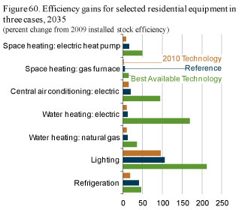By Elisa Wood
April 27, 2011
We’ve been hearing for years that the energy efficiency industry needs to find its equivalent to the cell phone. These days industry folks refer to it as the ‘killer app,” the revolutionary product or service that consumers can’t resist.
But lately, partly because I’m dieting, I’ve been thinking what energy efficiency really needs is something akin to a Weight Watchers dessert.
Let me explain myself.
Saving energy and saving calories share three precepts. They are most palatable to the consumer if they are devoid of self-sacrifice, appear invisible, and offer some element of delight. Weight Watchers has got these down cold. The energy efficiency industry is doing well with the first and second, but not the third.
No self-sacrifice
Weight Watchers is ingenious because it does not describe itself as a diet; it’s a lifestyle, a way of eating. It’s not about self-sacrifice. Sound familiar? The energy efficiency industry over the last decade shook off the ‘conservation’ moniker, much the way Weight Watcher abandoned the term ‘diet.’
The Alliance to Save Energy describes the difference between energy efficiency and conservation beautifully on its website:
But energy efficiency is a far cry from the energy conservation images and practices of old – of doing with less or doing without, of being uncomfortable or less comfortable. Not unlike the tremendous technological strides on the computer, electronics, and other fronts, energy efficiency takes advantage of advances in technology to provide significantly better, smarter services.
Invisible
On Weight Watchers you still can eat the macaroni and cheese. But it’s made with low fat milk. The calorie savings become invisible to me. Likewise, consumers can be energy efficient and still use their air conditioners and televisions as much as before. Appliance standards are the low fat milk of the energy industry. If you wonder about the significance of these standards read the efficiency section of the US Energy Information Administration’s recently released Annual Energy Outlook 2011. The report forecasts a 17% drop in residential per capita energy use through 2035 and says appliance standards often are “the primary reason for efficiency gains.” The currently controversial lighting standards create the biggest energy savings (See EIA chart below.)

Delight
This one is easy for Weight Watchers. It offers wonderful little chocolate cakes that bring delight to the sweet tooth. But what is energy efficiency’s chocolate cake? Herein rests the problem for the industry. The cell phone, the IPod, the home computer – these technologies were readily adapted because of the delight and convenience they add to our lives. As far as I can tell, neither the smart meter nor any of the other energy savings technologies being offered for the home offer any of this kind of allure. Some folks in the energy industry say they never will because information technology and energy technology part ways here. They may be right. But I remain hopeful. Those who had the first home computers (mine was a DEC Rainbow 100) may remember that they offered far more in the way of frustration than fun or inconvenience. These early computers left critics of the industry doubtful that widespread penetration of home computers would ever occur….and we all know how that all ended.
Elisa Wood is the co-author of the recent white paper, “Exporting US Energy Efficiency.”






No comments:
Post a Comment